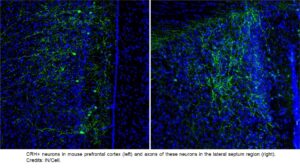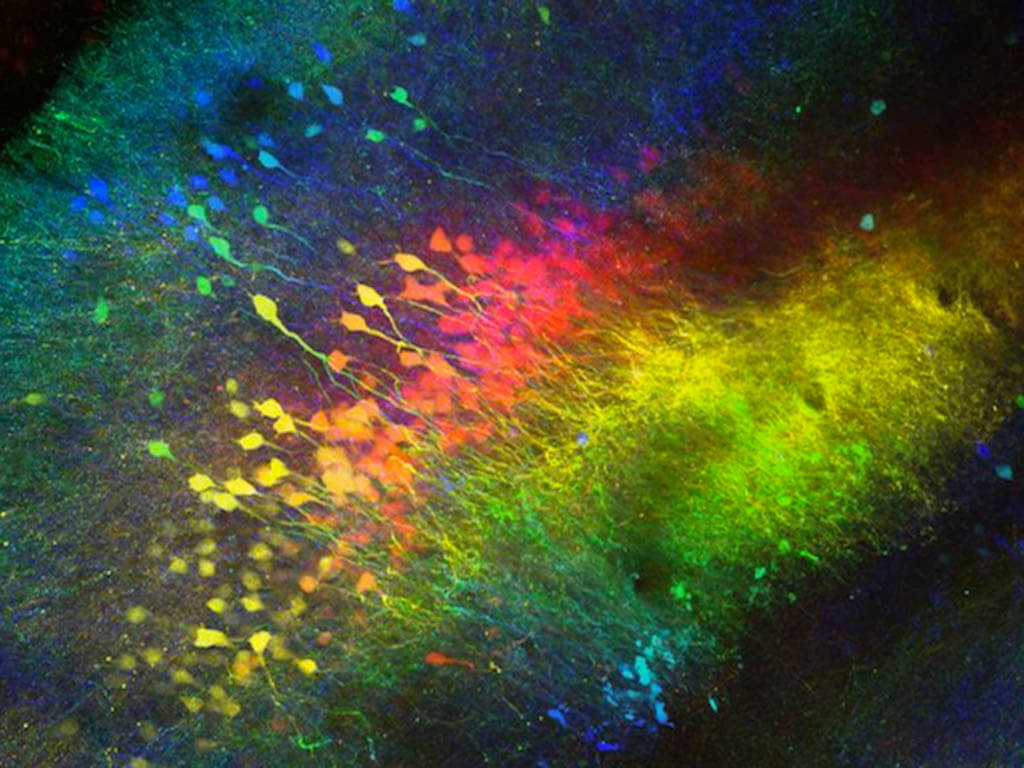Corticotropin-releasing hormone signaling from prefrontal cortex to lateral septum suppresses interaction with familiar mice.
A neural circuit suppresses social interaction with familiar individuals and promotes interactions with novel ones.
• Investigators have discovered a mechanism linking social memory with social novelty preference.
• These results could lead to the development of novel drugs for people suffering from social anxiety disorders such as avoidant personality or separation anxiety disorders.
(Photo: Antonia Ruiz Pino, Yuki Nomura, Noelia Sofía de León, Félix Leroy, Paula Sierra Díaz & Javier Paniagua)
Our drive to socialize with others is essential for a high-quality life. Within groups, our social preferences guide our choice to interact with one person over another under certain circumstances. Indeed, social preferences are essential for optimizing social interactions based on different contexts and needs. Like humans, mice also exhibit social preferences, with an intrinsic motivation to interact with novel individuals. However, until the publication of this study in the journal Cell, it was unknown whether their preference for social novelty originates from select brain circuits that promote novel social interactions or from circuits that suppress familiar ones.
With the aim of expanding knowledge about the neural circuits that guide social preference and solving this unknown, the Cognition and Social Interactions laboratory, led by Félix Leroy at the Institute for Neurosciences (Alicante, Spain), a joint center of the Spanish Research Council (CSIC) and the Miguel Hernández University (UMH) of Elche, has led a study carried out in mice. This work, in which investigators from the universities of Columbia and Washington have collaborated, describes, for the first time, a brain circuit that suppresses interactions with familiar individuals, to promote interactions with new individuals.
Specifically, the researchers from the Institute for Neurosciences CSIC-UMH discovered that a group of neurons in the prefrontal cortex, characterized by the expression of the neuropeptide corticotropin-releasing hormone (CRH), project to the region of the lateral septum (LS), a region long-known to be important for orchestrating a variety of motivated behaviors such as the search for comfort, security, food or socialization.
Through a combination of electrophysiological, chemogenetic, optogenetic, and gene silencing techniques, the researchers found that CRH-expressing neurons in the prefrontal cortex are activated by social familiarity which, in turn, releases CRH into the lateral septum. This release causes activation of the lateral septum thereby allowing interaction with known individuals to be reduced. Therefore, the release of CRH from the prefrontal cortex to the LS functions to support social novelty preference.
Contrary to adult rodents, pups prefer to interact with their relatives (brothers and mothers). This preference for relatives in pups is beneficial from an evolutionary point of view, given it guarantees the survival and correct development of the offspring. However, this preference must change during the postnatal period to foster the preference for social novelty in the adult and thus acquire social behaviors needed for adulthood. The experiments carried out in this study also show that the maturation of CRH expression in the prefrontal cortex during the first two weeks of life is a key component for the shift in social preference from familiar to novel individuals across development.

Up to 1% of the population may suffer from avoidant personality disorder which manifests itself as exaggerated introversion. In children, separation anxiety is one of the most common anxiety disorders and manifests itself as an unusually strong fear or anxiety of separating from the people with whom they feel a strong attachment. Importantly, dysregulation of the CRH neuropeptide system has been linked to a variety of anxiety-related phobias.
The researchers from the Institute for Neurosciences propose that low levels of CRH in the prefrontal cortex, as well as low levels CRH receptor in the lateral septum could lead to reduced social novelty preference in humans and therefore contribute to some of the symptoms associated with many social anxiety disorders: “We know that certain alterations in the gene that codes for CRH have previously been related to a higher incidence of behavioral disorders,” explains Noelia Sofía de León Reyes, first author of the article.
“Changes in social behavior are often associated with the onset of many psychiatric disorders and we know that the regions involved in our study are deregulated in various psychiatric disorders,” says Félix Leroy. The results of this work could lead to the development of new drugs targeting the CRH system to treat social anxiety disorders and other types of psychiatric illnesses that are associated with abnormal interactions, such as autism or depression.
This study has been supported by funding from the European Research Council (ERC) under the European Union’s Horizon 2020 research and innovation program, the CIDEGENT grant from the Valencian Community, and the Severo Ochoa Foundation. This work is part of the MotivatedBehaviors project (H202O-ERC-STG/0784, grant agreement n°949652), which aims to determine the role of the nucleus of the lateral septum in the regulation of motivated behaviors to uncover the changes occurring in disorders associated with deficits in social behavior.

 Español
Español

